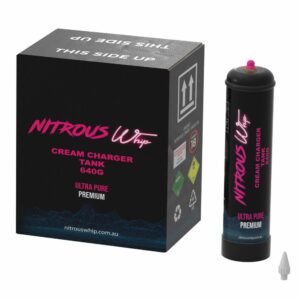Introduction
In a world progressively concerned about environmental sustainability, it's crucial to inspect every item we utilize, including those that seem harmless, like whip cream battery chargers. Whip cream battery charger tanks, frequently filled with nitrous oxide (N2O), have ended up being staples in kitchens, coffee bar, and dessert bars globally. Nevertheless, the question arises: what is their environmental impact? This article delves into the complexities surrounding cream battery charger tanks, the nitrous oxide contained within them, and their general effect on our planet.
The Environmental Effect of Whip Cream Charger Tanks
Whipped cream battery charger tanks serve a dual function: they supply a practical means to dispense whipped cream and are typically utilized recreationally for their blissful results. However, while lots of enjoy the advantages of these N2O cream charger tanks, few consider their ecological implications.
Understanding Nitrous Oxide and Its Effects
Nitrous oxide is a powerful greenhouse gas-- about 300 times more efficient at trapping heat in the environment than carbon dioxide over a century. When nitrous oxide is launched into the atmosphere, it adds to international warming and ozone exhaustion. While the majority of people view nitrous oxide as safe or even advantageous in medical settings, its recreational usage raises red flags relating to ecological responsibility.
Production of Whip Cream Battery Charger Tanks
The production procedure of whip cream charger tanks involves extracting nitrous oxide from nonrenewable fuel sources and mining operations. This extraction adds to environmental deterioration through habitat destruction and pollution. In addition, producing these chargers consumes energy and releases greenhouse gases into the atmosphere.
Disposal Challenges: What Takes Place After Use?
Once you've enjoyed your whipped cream reward or siphoned off some whippits, what takes place to the empty battery chargers? Numerous customers do not get rid of their Nang canisters properly. Improper disposal techniques include tossing them in routine trash or littering, leading to potential soil contamination and damage to wildlife.
The Life process Analysis of Cream Chargers
A life cycle analysis (LCA) considers every phase of an item's life-- from basic material extraction through producing to disposal:
Raw Product Extraction: As mentioned earlier, this step frequently results in habitat destruction. Manufacturing: Energy-intensive procedures result in considerable CO2 emissions. Distribution: Transferring these chargers contributes further to greenhouse gas emissions. Use: While using the product may seem safe, it releases N2O into the atmosphere. Disposal: Improper disposal leads to lose issues.Understanding this cycle helps clarify just just how much effect these tiny metal containers can have on our environment.
Sustainable Alternatives to Conventional Cream Chargers
As awareness grows regarding the ecological impact of whip cream charger tanks, makers are exploring sustainable options:
- Biodegradable Canisters: These are designed to reduce waste. Refillable Systems: Instead of single-use containers, refillable choices enable minimized waste. Alternative Gases: Research is ongoing into less harmful options to nitrous oxide.
These developments might revolutionize how we think about whipped cream dispensers and their role in our cooking experiences.
Consumer Responsibility in Mitigating Environmental Impact
While manufacturers hold obligation for sustainable practices, customers should likewise be proactive:
- Always recycle when possible. Opt for products with eco-friendly certifications. Educate others about responsible disposal methods.
By making informed choices, consumers https://telegra.ph/The-Art-of-Dessert-Making-with-Whipped-Cream-Charger-Tanks-02-10 can significantly reduce their carbon footprint related to using whip cream chargers.
Regulatory Actions Surrounding Nitrous Oxide Usage
In action to increasing issues about nitrous oxide's impact on climate modification, governments worldwide are beginning to take action:

This shift symbolizes growing acknowledgment that even little consumer products like whipped cream battery charger tanks deserve scrutiny under ecological regulations.
FAQs About Whip Cream Charger Tanks
1. What are whip cream charger tanks made of?
Whipped cream charger tanks are generally made from steel or aluminum created to hold pressurized nitrogen gas safely.
2. How do I get rid of empty nang canisters responsibly?
Most locations permit you to recycle empty containers; check local guidelines for specifics on recycling programs.
3. Can utilizing nitrous oxide cause health risks?
Yes, recreational usage can cause oxygen deprivation and other health issues if misused; constantly seek advice from an expert if unsure.
4. Are there environment-friendly alternatives available?
Yes! Choices consist of eco-friendly containers and refillable systems which help reduce waste significantly.
5. How does nitrous oxide contribute to environment change?
Nitrous oxide is a potent greenhouse gas that traps heat in the environment far more efficiently than co2 over time.
6. Can I reuse my whipped cream battery charger tank?
Many consumers discard them after one usage; nevertheless, refillable alternatives exist that allow you to decrease waste significantly.
Conclusion
In conclusion, while whip cream charger tanks may seem insignificant in our every day lives or cooking experiences, they carry significant weight worrying our world's health. Understanding the ecological effect of whip cream battery charger tanks requires all of us-- producers and customers alike-- to consider both our habits and choices thoroughly. Moving forward towards sustainable practices will ensure we preserve our environment while still delighting in life's little pleasures like whipped toppings atop desserts or coffee beverages guilt-free!

This post has checked out different elements concerning whip cream battery chargers' environmental effect-- from production procedures impacting environments down through customer behavior impacting waste management methods-- highlighting how interconnected these problems truly are!